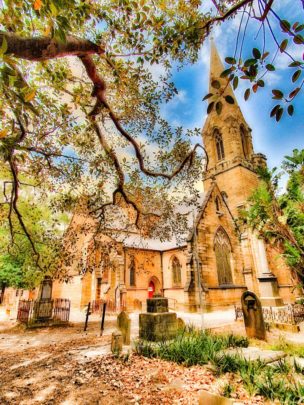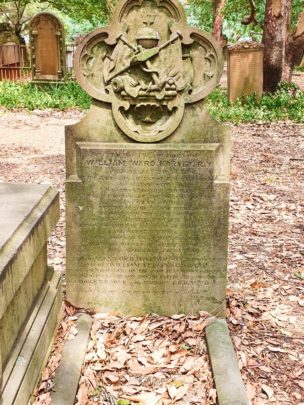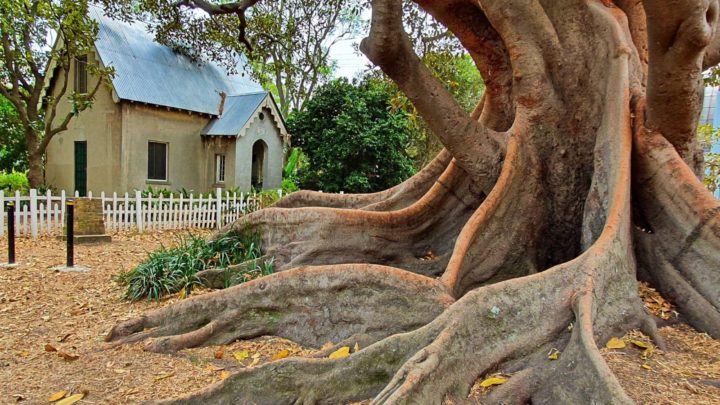‘A grave place to be: The fascinating secrets buried in one of Sydney’s oldest cemeteries’

I hadn’t noticed the activity elsewhere, it was new to me. People coming into graveyards; not to see any particular headstone or cast flowers on a loved one’s resting place; no, it was a sanctuary, a place for peace and quiet; people contemplating, reading, sitting on tombstones, an activity I was decidedly unfamiliar with, but somehow it seemed right. An escape from the throbbing pace of the inner city suburbs in a combined natural/unnatural world. It seemed so serendipitous.

Mature trees shaded the chosen spots, and, though the pews were somewhat coarse and solid, it seemed not to bother the patrons, if that is an appropriate word. They’d spread themselves out, way beyond the spectacular fig tree, one of the finest I’ve ever seen, and the splendid sandstone of the St Stephen the Martyr Church that usher one in at the entrance, the gap dotted here and there with reminders of what this place is all about, tombstones, and the first I read was of William Harvey of the Royal Navy who’d tragically drowned in 1853, along with others, in Sydney Harbour in a boating mishap when the HMS Torch’s cutter went sailing and was hit by a sudden southerly squall. It capsized but Harvey grabbed a couple of oars and heroically managed to get two boys to shore before he cramped and drowned, along with Alexander Dyce Wilson and William Veysey who are also remembered on the engraving.

Five from the wreck of the Dunbar, one of Australia’s most famous maritime disasters on South Head, are also here. Only one person of 121 survived the wreck but, miraculously it seems, the bible from the ship survived and is on show in the Rectory.
Tucked away beyond the fig tree on the right was the historic Cemetery Lodge (1848), erected at the same time the fig tree was planted, a sexton’s cottage I imagined, and it had the appearance of being lived in with potted plants at the entrance and a Christmas wreath hanging on the door.

The cemetery is the only one of the three original New South Wales graveyards that survives; the other two are these days known as the Town Hall and Central Station. There’s also a strong thread of the famous/infamous Bligh (depends on your point of view) going right through the veins of this place. The land was originally granted to the famous Captain then purchased from Bligh’s son-in-law Sir Maurice Charles O’Connell in 1848 and, in 1849, he was the first person buried here though it was actually a re-internment. Then, Bligh’s great-grandson, Richard Stuart O’Connell, was one of the final burials in the cemetery, nearly 100 years later.
The Camperdown suburb itself was named by none other than Captain Bligh himself, after a naval battle in which he’d fought in 1797. His daughter married again after her first husband died. It was to Sir Maurice O’Connell, former Lieutenant Governor of NSW, one of the great characters in early Australia. Sir Maurice started a racecourse where the Royal Prince Alfred Hospital now stands. His grave carries a very apt quotation from Job, “I caused the widow’s heart to rejoice,” but, during his never-to-be-forgotten large military funeral, a wild bull charged and scattered the ceremonial redcoats everywhere.
William Nash was another notable. A gold buyer, he made a fortune and, at one stage, returned to England with a wish to drive an eight-horse coach. Informed that only royalty could do such a thing, he got a team of seven horses and one mule. It is recorded that Queen Victoria was not amused.
Emily Donnithorne, believed to be the original of Dickens’ Miss Havisham in Great Expectations, also can be found here. Jilted on her wedding day in 1852, this poor young lady shut herself in her house, the wedding breakfast still laid out in the dining-room, and never re-emerged until her death in 1886. Extraordinary!
Weather has not been kind to many of the older sandstone monuments and tantalising dates pop up but often their story has been lost. John Roote Andrews was the stonemason for 90 per cent of the burials and the land was virtually filled up after only 20 years, with just selected burials after that.
Another noted character in the cemetery was Nicholas Boscha, something of a rogue in sheep’s clothing. Once official harpist to the Emperor Napoleon, he became more noted as a devil with the ladies, so much so that he fled France a jump ahead of imprisonment for bigamy and was he was befriended by Sir Roley Bishop, a great English musician. Far from returning the favour, he promptly made off with Bishop’s wife, young opera singer Anna, and finally came to Australia with her in 1855.
He died here in January, 1856. His fine headstone was erected by the sorrowing Anna. Reverend George, once a guide here, said “He was a fine musician and teacher, he’s credited with introducing the modern playing of the harp. What that means, I don’t really know. Nor do I know what he’s playing now!”
Should you make the journey here, allow yourself time to soak the stories and atmosphere up. I recommend at least 2 hours and, on the first Sunday of every month, there’s a guided tour. Check Camperdown Cemetery’s website for details.












 Proudly Australian owned and operated
Proudly Australian owned and operated